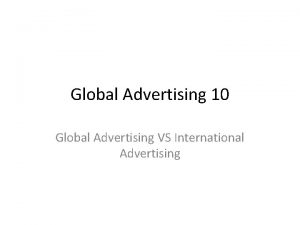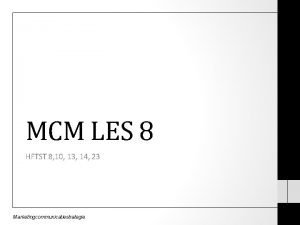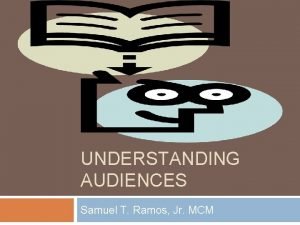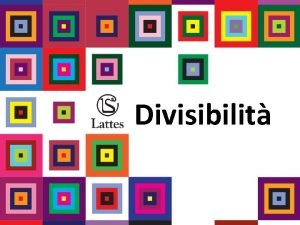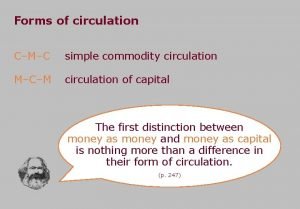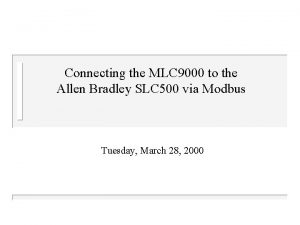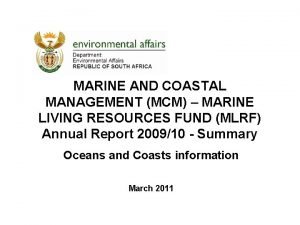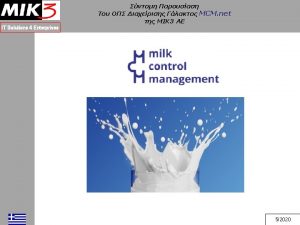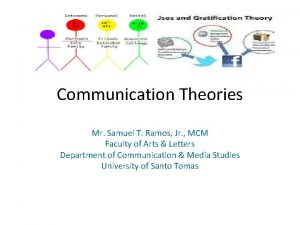ADVERTISING Prof Samuel T Ramos Jr MCM Philippine



















![Commercial television in the 1950 s[edit] In the early 1950 s, the Du. Commercial television in the 1950 s[edit] In the early 1950 s, the Du.](https://slidetodoc.com/presentation_image/85a3e368ecd497d4ab39774ecca0726d/image-20.jpg)








- Slides: 28

ADVERTISING Prof. Samuel T. Ramos, Jr. , MCM Philippine Christian University College of Arts, Sciences & Social Work Department of Mass Communication

Advertising is a form of marketing communication used to promote or sell something, usually a business's product orservice. Advertising by a government in favor of its own policies is often called propaganda. In Latin, ad vertere means "to turn toward". The purpose of advertising may also be to reassure employees or shareholders that a company is viable or successful. Advertising messages are usually paid for by sponsors and viewed via various old media; including mass media such as newspapers, magazines, Television, Radio, outdoor advertising or direct mail; or new media such as blogs, websites or text messages.

Commercial ads seek to generate increased consumption of their products or services through "branding, " which associates a product name or image with certain qualities in the minds of consumers. Noncommercial advertisers who spend money to advertise items other than a consumer product or service include political parties, interest groups, religious organizations and governmental agencies. Non-profit organizations may use free modes of persuasion, such as a public service announcement.

Modern advertising was created with the techniques introduced with tobacco advertising in the 1920 s, most significantly with the campaigns of Edward Bernays, considered the founder of modern, "Madison Avenue" advertising. In 2015, the world spent an estimate of US$592. 43 billion on advertising. Internationally, the largest ("big four") advertising conglomerates are Interpublic, Omnicom, Publicis, and WPP.


HISTORY Egyptians used papyrus to make sales messages and wall posters. Commercial messages and political campaign displays have been found in the ruins of Pompeii and ancient Arabia. Lost and found advertising on papyrus was common in Ancient Greece and Ancient Rome. Wall or rock painting for commercial advertising is another manifestation of an ancient advertising form, which is present to this day in many parts of Asia, Africa, and South America. The tradition of wall painting can be traced back to Indian rock art paintings that date back to 4000 BC

In ancient China, the earliest advertising known was oral, as recorded in the Classic of Poetry (11 th to 7 th centuries BC) of bamboo flutes played to sell candy. Advertisement usually takes in the form of calligraphic signboards and inked papers. A copper printing plate dated back to the Song dynasty used to print posters in the form of a square sheet of paper with a rabbit logo with "Jinan Liu's Fine Needle Shop" and "We buy high-quality steel rods and make fine-quality needles, to be ready for use at home in no time" written above and below is considered the world's earliest identified printed advertising medium.

In Europe, as the towns and cities of the Middle Ages began to grow, and the general populace was unable to read, instead of signs that read "cobbler", "miller", "tailor", or "blacksmith", images associated with their trade would be used such as a boot, a suit, a hat, a clock, a diamond, a horse shoe, a candle or even a bag of flour. Fruits and vegetables were sold in the city square from the backs of carts and wagons and their proprietors used street callers (town criers) to announce their whereabouts for the convenience of the customers. The first compilation of such advertisements was gathered in "Les Crieries de Paris", a thirteenth-century poem by Guillaume de la Villeneuve

In the 18 th century advertisements started to appear in weekly newspapers in England. These early print advertisements were used mainly to promote books and newspapers, which became increasingly affordable with advances in the printing press; and medicines, which were increasingly sought after as disease ravaged Europe. However, false advertising and so-called "quack" advertisements became a problem, which ushered in the regulation of advertising content.

19 TH CENTURY Thomas J. Barratt from London has been called "the father of modern advertising". Working for the Pears Soapcompany, Barratt created an effective advertising campaign for the company products, which involved the use of targeted slogans, images and phrases. One of his slogans, "Good morning. Have you used Pears' soap? " was famous in its day and into the 20 th century.

Barratt introduced many of the crucial ideas that lie behind successful advertising and these were widely circulated in his day. He constantly stressed the importance of a strong and exclusive brand image for Pears and of emphasizing the product's availability through saturation campaigns. He also understood the importance of constantly reevaluating the market for changing tastes and mores, stating in 1907 that "tastes change, fashions change, and the advertiser has to change with them. An idea that was effective a generation ago would fall flat, stale, and unprofitable if presented to the public today. Not that the idea of today is always better than the older idea, but it is different – it hits the present taste. " As the economy expanded across the world during the 19 th century, advertising grew alongside. In the United States, the success of this advertising format eventually led to the growth of mail-order advertising.

In June 1836, French newspaper La Presse was the first to include paid advertising in its pages, allowing it to lower its price, extend its readership and increase its profitability and the formula was soon copied by all titles. Around 1840, Volney B. Palmer established the roots of the modern day advertising agency in Philadelphia. In 1842 Palmer bought large amounts of space in various newspapers at a discounted rate then resold the space at higher rates to advertisers. The actual ad – the copy, layout, and artwork – was still prepared by the company wishing to advertise; in effect, Palmer was a space broker. The situation changed in the late 19 th century when the advertising agency of N. W. Ayer & Son was founded. Ayer and Son offered to plan, create, and execute complete advertising campaigns for its customers. By 1900 the advertising agency had become the focal point of creative planning, and advertising was firmly established as a profession.

Around the same time, in France, Charles- Louis Havas extended the services of his news agency, Havas to include advertisement brokerage, making it the first French group to organize. At first, agencies were brokers for advertisement space in newspapers. N. W. Ayer & Son was the first full-service agency to assume responsibility for advertising content. N. W. Ayer opened in 1869, and was located in Philadelphia.

20 th century A 1900 advertisement for Pears soap. A print advertisement for the 1913 issue of the Encyclopædia Britannica. Advertising increased dramatically in the United States as industrialization expanded the supply of manufactured products. In order to profit from this higher rate of production, industry needed to recruit workers as consumers of factory products. It did so through the invention of mass marketing designed to influence the population's economic behavior on a larger scale. In the 1910 s and 1920 s, advertisers in the U. S. adopted the doctrine that human instincts could be targeted and harnessed – "sublimated" into the desire to purchase commodities. Edward Bernays, a nephew of Sigmund Freud, became associated with the method and is sometimes called the founder of modern advertising and public relations.

In the 1920 s, under Secretary of Commerce Herbert Hoover, the American government promoted advertising. Hoover himself delivered an address to the Associated Advertising Clubs of the World in 1925 called 'Advertising Is a Vital Force in Our National Life. " In October 1929, the head of the U. S. Bureau of Foreign and Domestic Commerce, Julius Klein, stated "Advertising is the key to world prosperity. " This was part of the "unparalleled" collaboration between business and government in the 1920 s, according to a 1933 European economic journal. The tobacco companies became major advertisers in order to sell packaged cigarettes. The tobacco companies pioneered the new advertising techniques when they hired Bernays to create positive associations with tobacco smoking

Advertising was also used as a vehicle for cultural assimilation, encouraging workers to exchange their traditional habits and community structure in favor of a shared "modern" lifestyle. An important tool for influencing immigrant workers was the American Association of Foreign Language Newspapers (AAFLN). The AAFLN was primarily an advertising agency but also gained heavily centralized control over much of the immigrant press.

At the turn of the 20 th century, there were few career choices for women in business; however, advertising was one of the few. Since women were responsible for most of the purchasing done in their household, advertisers and agencies recognized the value of women's insight during the creative process. In fact, the first American advertising to use a sexual sell was created by a woman – for a soap product. Although tame by today's standards, the advertisement featured a couple with the message "A skin you love to touch".

In the 1920 s psychologists Walter D. Scott and John B. Watson contributed applied psychological theory to the field of advertising. Scott said, "Man has been called the reasoning animal but he could with greater truthfulness be called the creature of suggestion. He is reasonable, but he is to a greater extent suggestible". He demonstrated this through his advertising technique of a direct command to the consumer.

On the radio from the 1920 s Advertisement for a live radio broadcast, sponsored by a milk company, Adohr milk, and published in the Los Angeles Times on May 6, 1930 In the early 1920 s, the first radio stations were established by radio equipment manufacturers and retailers who offered programs in order to sell more radios to consumers. As time passed, many non-profit organizations followed suit in setting up their own radio stations, and included: schools, clubs and civic groups. When the practice of sponsoring programs was popularized, each individual radio program was usually sponsored by a single business in exchange for a brief mention of the business' name at the beginning and end of the sponsored shows. However, radio station owners soon realized they could earn more money by selling sponsorship rights in small time allocations to multiple businesses throughout their radio station's broadcasts, rather than selling the sponsorship rights to single businesses per show.
![Commercial television in the 1950 sedit In the early 1950 s the Du Commercial television in the 1950 s[edit] In the early 1950 s, the Du.](https://slidetodoc.com/presentation_image/85a3e368ecd497d4ab39774ecca0726d/image-20.jpg)
Commercial television in the 1950 s[edit] In the early 1950 s, the Du. Mont Television Network began the modern practice of selling advertisement time to multiple sponsors. Previously, Du. Mont had trouble finding sponsors for many of their programs and compensated by selling smaller blocks of advertising time to several businesses. This eventually became the standard for the commercial television industry in the United States. However, it was still a common practice to have single sponsor shows, such as The United States Steel Hour. In some instances the sponsors exercised great control over the content of the show – up to and including having one's advertising agency actually writing the show. The single sponsor model is much less prevalent now, a notable exception being the Hallmark Hall of Fame

Cable television from the 1980 s The late 1980 s and early 1990 s saw the introduction of cable television and particularly MTV. Pioneering the concept of the music video, MTV ushered in a new type of advertising: the consumer tunes in for the advertising message, rather than it being a byproduct or afterthought. As cable and satellite television became increasingly prevalent, specialty channelsemerged, including channels entirely devoted to advertising, such as QVC, Home Shopping Network, and Shop. TV Canada.

On the Internet from the 1990 s With the advent of the ad server, online advertising grew, contributing to the "dot-com" boom of the 1990 s. Entire corporations operated solely on advertising revenue, offering everything from coupons to free Internet access. At the turn of the 21 st century, some websites, including the search engine Google, changed online advertising by personalizing ads based on web browsing behavior. This has led to other similar efforts and an increase in interactive advertising

The share of advertising spending relative to GDP has changed little across large changes in media since 1925. In 1925, the main advertising media in America were newspapers, magazines, signs on streetcars, and outdoor posters. Advertising spending as a share of GDP was about 2. 9 percent. By 1998, television and radio had become major advertising media. Nonetheless, advertising spending as a share of GDP was slightly lower – about 2. 4 percent.

Guerrilla marketing involves unusual approaches such as staged encounters in public places, giveaways of products such as cars that are covered with brand messages, and interactive advertising where the viewer can respond to become part of the advertising message. This type of advertising is unpredictable, which causes consumers to buy the product or idea. This reflects an increasing trend of interactive and "embedded" ads, such as via product placement, having consumers vote through text messages, and various campaigns utilizing social network services such as Facebook or Twitter. The advertising business model has also been adapted in recent years. In media for equity, advertising is not sold, but provided to start-up companies in return for equity. If the company grows and is sold, the media companies receive cash for their shares.

Domain name registrants (usually those who register and renew domains as an investment) sometimes "park" their domains and allow advertising companies to place ads on their sites in return for per-click payments. These ads are typically driven by pay per click search engines like Google or Yahoo, but ads can sometimes be placed directly on targeted domain names through a domain lease or by making contact with the registrant of a domain name that describes a product. Domain name registrants are generally easy to identify through WHOIS records that are publicly available at registrar websites.

ADVERTISING THEORY Hierarchy-of-effects models Various competing models of hierarchies of effects attempt to provide a theoretical underpinning to advertising practice. The model of Clow and Baack clarifies the objectives of an advertising campaign and for each individual advertisement. The model postulates six steps a buyer moves through when making a purchase: � � � Awareness Knowledge Liking Preference Conviction Purchase Means-End Theory suggests that an advertisement should contain a message or means that leads the consumer to a desired end-state. Leverage Points aim to move the consumer from understanding a product's benefits to linking those benefits with personal values.

MARKETING MIX The marketing mix was proposed by professor E. Jerome Mc. Carthy in the 1960 s. It consists of four basic elements called the "four Ps". Product is the first P representing the actual product. Price represents the process of determining the value of a product. Place represents the variables of getting the product to the consumer such as distribution channels, market coverage and movement organization. The last P stands for Promotion which is the process of reaching the target market and convincing them to buy the product. In the 1990 s, the concept of four Cs was introduced as a more customer-driven replacement of four P's. There are two theories based on four Cs: Lauterborn's four Cs (consumer, cost, communication, convenience) and Shimizu's four Cs (commodity, cost, communication, channel) in the 7 Cs Compass Model (Co-marketing). Communications can include advertising, sales promotion, public relations, publicity, personal selling, corporate identity, internal communication, SNS, MIS. [38][39][40][41]

TYPES OF ADVERTISING An advertisement for the Wikimedia Foundation. An advertisement for a diner. Such signs are common on storefronts. Paying people to hold signs is one of the oldest forms of advertising, as with this human billboard. A bus with an advertisement for. GAP in Singapore. Buses and other vehicles are popular media for advertisers. Mobile Billboard in East Coast Park, Singapore. A DBAG Class 101 with UNICEFads at Ingolstadt main railway station. A London Bus, with a filmadvertisement along its side. Hot air balloon displays advertising for GEO magazine Virtually any medium can be used for advertising. Commercial advertising media can include wall paintings, billboards, street furniture components, printed flyers and rack cards, radio, cinema and television adverts, web banners, mobile telephone screens, shopping carts, web popups, skywriting, bus stop benches, human billboards and forehead advertising, magazines, newspapers, town criers, sides of buses, banners attached to or sides of airplanes ("logojets"), in -flight advertisements onseatback tray tables or overhead storage bins, taxicab doors, roof mounts and passenger screens, musical stage shows, subway platforms and trains, elastic bands on disposable diapers, doors of bathroom stalls, stickers on apples in supermarkets, shopping cart handles (grabertising), the opening section of streaming audio and video, posters, and the backs of event tickets and supermarket receipts. Any place an "identified" sponsor pays to deliver their message through a medium is advertising.
 Habla señor que tu siervo escucha
Habla señor que tu siervo escucha Global advertising and international advertising
Global advertising and international advertising Anticyclisch budgetteren
Anticyclisch budgetteren Mcm audience
Mcm audience Mcm/icm
Mcm/icm Scomposizione in fattori primi di 1575
Scomposizione in fattori primi di 1575 Mcm de expresiones algebraicas
Mcm de expresiones algebraicas C-m-c m-c-m
C-m-c m-c-m Mcm 2012
Mcm 2012 3150-mcm
3150-mcm Rdo mcm
Rdo mcm Conjunto
Conjunto Factores primos de un polinomio
Factores primos de un polinomio Mdm vs mam vs mcm
Mdm vs mam vs mcm Master chemical mechanism
Master chemical mechanism Mcm authenticator
Mcm authenticator Mandiri cash mana
Mandiri cash mana Desired packaging
Desired packaging Recarga mcm
Recarga mcm Mcm agenda
Mcm agenda Mcm
Mcm Riduzione al minimo comune denominatore
Riduzione al minimo comune denominatore Creature framework mcm
Creature framework mcm Anomaly mcm
Anomaly mcm Ecuaciones con fracciones algebraicas 4 eso
Ecuaciones con fracciones algebraicas 4 eso Dr ernesto ramos martinez
Dr ernesto ramos martinez Jorge ramos fun facts
Jorge ramos fun facts Contabilidade mercado de trabalho
Contabilidade mercado de trabalho Lectio divina domingo de ramos ciclo c
Lectio divina domingo de ramos ciclo c

